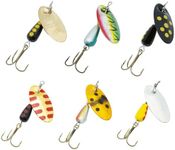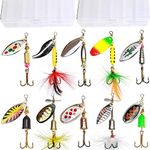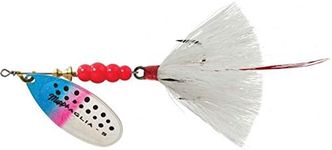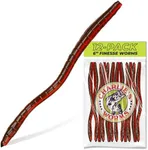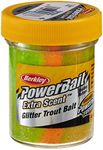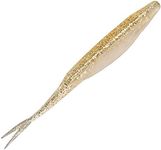Buying Guide for the Best Rainbow Trout Lures
Choosing the right lure for rainbow trout fishing can significantly enhance your chances of a successful catch. Rainbow trout are known for their vibrant colors and fighting spirit, making them a popular target for anglers. The key to selecting the best lure lies in understanding the different types of lures available and how they align with your fishing conditions and personal preferences. Here are some key specifications to consider when picking rainbow trout lures.Lure TypeLure type refers to the design and function of the lure. Common types include spinners, spoons, soft plastics, and crankbaits. Spinners create vibrations and flash in the water, attracting trout from a distance. Spoons mimic the movement of small fish, making them effective for triggering strikes. Soft plastics can imitate various prey and offer versatility in presentation. Crankbaits are designed to dive and wobble, resembling injured baitfish. Choose a lure type based on the water conditions and the behavior of the trout in your fishing area.
SizeThe size of the lure is crucial because it needs to match the prey that rainbow trout are feeding on. Smaller lures (1-3 inches) are ideal for clear water and when trout are feeding on small insects or fry. Medium-sized lures (3-5 inches) work well in a variety of conditions and can imitate larger prey. Larger lures (5 inches and above) are suitable for targeting bigger trout or when fishing in murky waters. Consider the size of the trout you are targeting and the clarity of the water when selecting the lure size.
ColorColor plays a significant role in attracting rainbow trout. Bright colors like orange, pink, and chartreuse are effective in murky or stained water as they stand out more. Natural colors like silver, gold, and brown are better suited for clear water, mimicking the natural prey of trout. UV and glow-in-the-dark colors can be useful in low-light conditions or deep water. Match the color of your lure to the water conditions and the natural prey in the area to increase your chances of success.
ActionThe action of a lure refers to how it moves in the water. Some lures have a wobbling action, while others may spin, dart, or glide. The action can trigger a predatory response from rainbow trout. For example, a wobbling spoon can mimic an injured fish, while a spinning lure can create vibrations that attract trout from a distance. Experiment with different actions to see what works best in your fishing spot. Pay attention to how the trout respond to different movements and adjust accordingly.
WeightThe weight of the lure affects how deep it will sink and how far you can cast it. Lighter lures (1/16 to 1/8 ounce) are suitable for shallow waters and when a delicate presentation is needed. Medium-weight lures (1/8 to 1/4 ounce) are versatile and can be used in various depths and conditions. Heavier lures (1/4 ounce and above) are ideal for deep water or when you need to cast long distances. Consider the depth of the water you are fishing in and the casting distance required when choosing the weight of your lure.

